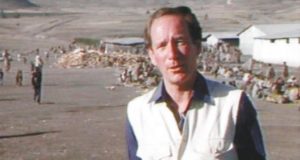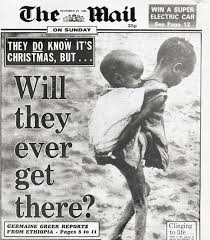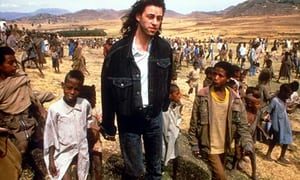“It was worse than Hell”: The Famine’s Remembrance – Ellie Hewes
Imagine this: You are in Ethiopia, either a mother, a father, a child, who you are now. Around you, there is constant screaming from either the mental pain of not having somebody there anymore due to the death of starvation or the physical pain of their stomachs cramping every second of every day, pleading for food. Around you, the scorching heat at day, the freezing weather at night and all that protects you from the predators which live off of your nothing other than flesh and bones is a tent or a ragged piece of material once worn by the rich in the West. Rumours fly around about the shipping of food, of fresh clothes but 90% of the time, it is just fake. Another day will go by without food. You see mothers and fathers scrabbling around in the dirt for grains of food, the only food they may have got in the fortnight or longer. Doctors try to help people, for example, giving drips to the most needy but the problem is that they cannot give them medicines like tablets and injections as they do not have any food and so would make them worse. The dead are laid out. It is described “worse than Hell”. A minimum of 30 every night. Somebody dies every 20 minutes. As people flee from other parts of Ethiopia, places such as Tigre, the numbers of the dead will inevitably grow. The Ethiopian government tells these people to go home but that would make death certain. The most needy are taken by the Ethiopian government to go to small barns which are packed with thousands of people. However, how can you choose who is the most needy when everybody here is a walking skeleton. One doctor said he had his head in his hands trying to pick the most needy. He said “even when I think of it know, it gives me a nightmare”. Many organisations come here to give any spare clothes, everybody’s sunken eyes on them, watching every movement in the hope that they will be given the mark to allow them to have food and clothes.

This was the reality of the Ethiopian famine in 1983-1985 captured by the Kenyan cameraman, Mohammed Amin. All these elements were brought out in the explicit video presented by Micheal Buerk in the BBC 7 minute programme. Within the first sentence, the chill of what was reality compared to what we have in TNC,s such as the UK, came to light. Buerk described: “Dawn, and as the sun breaks through the piercing chill of night on the plains outside Korem, it lights up a biblical famine, now, in the 20th century. This place, say workers here, is the closest thing to hell on earth.”The photos brought about, shook the world. The moral side was developed but an over view of what brought out this famine, was especially important and why this humanitarian catastrophe is still carrying on. What has been done to change this? As the 25th anniversary embarks on us, many of us will remember this catastrophe. The famine in Ethiopia caused an estimated 1 million deaths and left a million more destitute, fit for an inevitable death.
What came to light when researching this topic and watching this one video alone were questions such as: Why aren’t places such the UK and Germany and other huge TNC’s aiding them? Why are we any different to the other children and him and in Ethiopia? How are we? Why did we get chosen to live in luxury and them live in malnutrition and poverty? I didn’t get why we were not distributing food around. How can you pick who is the most needy when everybody you look at in every direction is starved to the brink of death? A nurse called Claire Bertschinger was one of the unfortunate people tasked with this decision and specifically with the children. She wrote in her autobiography that she “felt like a Nazi, sending people to death, concentration camps”. She carried on to query “why was I in this situation”? “Why was it possible in this time of plenty that some have food and some not”? It is something I had a lack of understanding of and intrigued me. Both of us had queried the same things.
This BBC video soon went viral. It was transmitted from 425 TV stations across the globe. Many of the Americans especially wanted to keeps Buerk’s voice as they described it as “the determinedly dispassionate British voice of Buerk” (even though it opposed all accepted practises there). Not only this, but aid agencies came to the report. They said that this would prove as evidence of the apathy of the Western Government to this death ridden famine.

Amongst the many who saw this video, was the Irish star: Bob Geldof. Many may recognise his name as the man who wrote the lyrics to the Christmas song: “Do they Know It’s Christmas”, basing his lyrics off of those who he’d seen in the Hell realms of the famine. On the 25th October 1984, he brought all of the “British Pop Royalty” figures such as Boomtown Rats, Midge Uhr, Phil Collins, Wham, Culture Club and many more. After being released, this song was titled “a global phenomenon”. It became the UK’s biggest selling single, reaching 3.75 million sales and raising alone, £8 million for the famine relief. It was one of the top 15 in the European charts, touching many lyrics which referred to the famine at Christmas time such as: “feed the world” as the chorus, “being peace and joy this Christmas to West Africa”, “a song of hope they’ll have is being alive”, “why is comfort deadly fear”, “here’s to you, here’s to them”, “there’s no need to be afraid”, “there’s a world outside your window, it is a world of dread and fear”, “where a kiss of love can kill you and there is a death in every fear”, “and the Christmas bells that ring, are the clanging chimes of doom”. This ultimately was the formation of Band Aid.
Geldof saw the success of his Band Aid and it then inspired him to set up Live Aid. This was when there would be mass concerts held in big arenas all across the world; arenas such as Wembley. He managed to raise £150 million for the famine relief alone!
The Ethiopian famine was started through the lack of money to get the food. This was due to the disastrous policies put in place during the Northern Civil War. The money was put into winning the war and left thousands without the money to pay for survival. Not only this, but harvests also failed in 1891. This carried on until 1984. There were not the usual rains and disease had especially become abundant, killing even more of their crops. Many aid agencies were accusing the Ethiopian government of neglecting their people by not listening to these warning signals of famine over the years. For example, with the famine, they were very slow to become involved and give aid to their people. It’s aid to their country was rated one of the worst compared to most other developing countries. The Ethiopian government had suspected that at the end of March, many were at the risk of starvation (5 million) due to only 6.2 million tonnes of grain for the country annually. This was due to not having the extra one million tonnes which they needed for their people to survive. By the Summer, they were aware that many were dying, in fact thousands! Now, 6 million were believed to be at risk but the government were still reluctant on becoming involved.

In September, aid agencies such as Oxfam wanted to get involved and raised the largest donation in a 40 year history of £500,000! However, it was found that the Ethiopian government were giving out food that the aid agencies had given them and raised money for for the famine, were being instead distributed to their troops fighting in the civil war! Places such as the UK had given millions that they had raised in 3 days through aircraft Hercules and yet still the government were using it for the greater good of themselves! They were even reluctant to this help given by the RAF which had arrived in the captives city called Addis Abada, sponsored by the Daily Mirror, delivering 20 tones of food. However, according to Buerk, he had said that this was not enough to last 20 minutes! There were major delays in this process and many diplomatic disagreements. Before this, in the previous month, it had been estimated that whatever the level of aid given, it wasn’t going to be enough to save the lives as it was too big a task. Aid agencies were appealing for 60,000 tonnes however this couldn’t be enough, they needed more and so resulted to market grain. After the viral videos of explicit images and scenes, many of the public embarked on trying to help and especially things such as Band Aid and Live Aid definitely helped. However, this was still not deemed enough by the Ethiopian government! Millions were raised but this went towards funding their civil war! Not only this, but yet again the storms were failing. This time, the large heavy storms swamped the crops and killed them off. Many thousands fled from across the country to a Sudan from war, famine or drought. Over 2000 were thought to arrive each day in December 1984!
Through researching this topic, it has really given a mix of emotions. Frustration that famines are still around now, even in Ethiopia. Governments prefer to be selfish and put it towards their own power with others in their country rather than helping their own people. Sadness definitely. Sadness that through the governments own putrid actions, many have died. The government have indirectly killed their own people. Sadness of the amount of deaths, the way these humans were handled, left to their own inevitable death and others around them too. However, it is important to note the individuals such as Bob Geldof; someone to be remembered for trying to minimise the deaths apparent. He saved their lives along with other aid emergencies and groups such as Oxfam, Mirror, the RAF, Buerk and Amin and many others who have captured these experiences into short, shocking videos but have done something to help these strangers, no matter what their background is, weather they know them or not, they chose to counteract the indirect murdering of the people so they could survive and minimise inevitable deaths.















Post Comment
You must be logged in to post a comment.